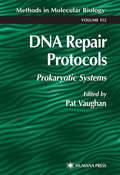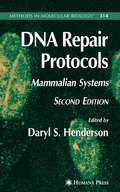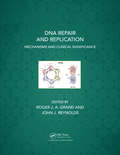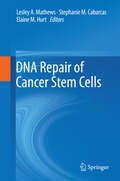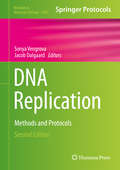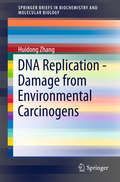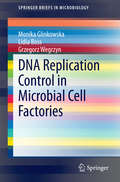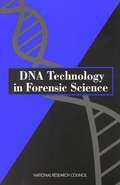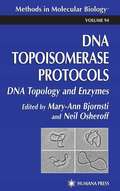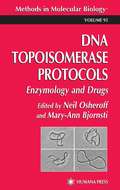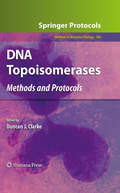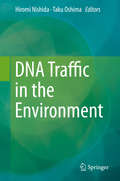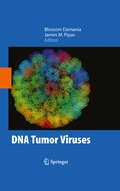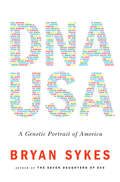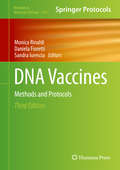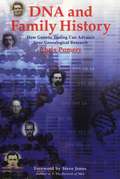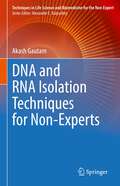- Table View
- List View
DNA Repair Protocols
by Pat VaughanWell-versed investigators describe in step-by-step detail a wide range of DNA repair activities, from single act-alone repair proteins to complex repair systems. These practical protocols not only detail the various repair activities found in cells, but also demonstrate the use of DNA repair proteins and systems as reagents in molecular biology and biotechnology. The techniques described here include mutation and polymorphism detection, which are useful in the search for disease genes and drug response genes, as well as for breeding and trait selection in animals and plants. Compact and highly practical, DNA Repair Protocols: Prokaryotic Systems provides expert guidance to both the DNA repair researcher studying the fundamental aspects of DNA repair and the applied researcher in human genetics and biotechnology.
DNA Repair Protocols: Mammalian Systems, 2nd Edition
by Daryl S. HendersonIn this second edition of a much praised laboratory manual devoted to eukaryotic systems, Daryl S. Henderson has refocused the book on mammalian cells, adding fourteen entirely new chapters and extensively revising many of the remaining chapters. The authors address a broad range of questions about practical mammalian DNA repair, including such arcana as "what is radioresistant DNA synthesis and how is it measured?" The techniques presented are readily reproducible and offer cutting-edge methods for cytogenetic analysis, measuring the cellular response to ionizing radiation, detecting single-strand (nicks) and double-strand DNA breaks, detecting the presence of "adducted" bases in DNA, and preparing mismatch repair (MMR) plasmid substrates. Among the highlights are excellent coverage of both base excision repair (BER) and nucleotide excision repair (NER), useful assays for identifying and quantifying UV-induced DNA lesions and DNA breakage, gene therapy, environmental mutagenesis and cancer, and gene targeting. The protocols follow the successful Methods in Molecular Biology™ series format, each offering step-by-step laboratory instructions, an introduction outlining the principles behind the technique, lists of the necessary equipment and reagents, and tips on troubleshooting and avoiding known pitfalls.<P><P> Authoritative and highly practical, DNA Repair Protocols: Mammalian Systems, Second Edition, offers investigators a wide variety of productive methods to explore and make new discoveries in the world of mammalian DNA repair.
DNA Repair and Replication: Mechanisms and Clinical Significance
by Roger J. Grand John J. ReynoldsDNA Repair and Replication brings together contributions from active researchers. The first part of this book covers most aspects of the DNA damage response, emphasizing the relationship to replication stress. The second part concentrates on the relevance of this to human disease, with particular focus on both the causes and treatments which make use of DNA Damage Repair (DDR) pathways.
DNA Repair of Cancer Stem Cells
by Stephanie M Cabarcas Lesley A Mathews Elain HurtThe existence of 'cancer stem cells' (CSCs) has been a topic of heated debate for the last few years within the field of cancer biology. Their continuous characterization in a variety of solid tumors has lead to an abundance of evidence supporting their existence. CSCs are believed to be responsible for resistance against conventional treatment regimes of chemotherapy and radiation, ultimately, leading to metastasis and patient demise. To help aid clinicians, pharmaceutical companies and academic labs investigating how to better kill these highly aggressive cells we have summarized the DNA repair mechanism(s) and their role in the maintenance and regulation of both normal and cancer stem cells. Our book represents a comprehensive investigation into the highly effective DNA repair mechanisms of CSCs and what we need to understand in order to develop more advanced therapies to eradicate them from patients. Currently, there are no other published works entirely on DNA repair and Cancer Stem Cells. In addition, our book provides a comprehensive overview of CSC isolation and characterization from a variety of solid tumor types.
DNA Replication
by Sonya Vengrova Jacob DalgaardSince the discovery of DNA structure and throughout the ensuing "DNA era", the field of DNA replication has expanded to cover a vast number of experimental systems. In DNA Replication: Methods and Protocols, expert researchers present a collection of techniques and approaches used to investigate DNA replication with an emphasis on the most recent technological developments. Beginning with several informative introductory review chapters, this extensive volume is organized for clarity while fully encouraging innovation by the mixing of methods to create new techniques. Written in the highly successful Methods in Molecular Biology(tm) series format, chapters contain brief introductions to the topics, lists of the necessary materials and reagents, step-by-step, readily reproducible laboratory protocols, and notes on troubleshooting and avoiding known pitfalls. Comprehensive and cutting-edge, DNA Replication: Methods and Protocols provides an excellent tool for both established laboratories and individuals new to this exciting field of research.
DNA Replication
by Jacob Z. Dalgaard Sonya VengrovaSince the discovery of DNA structure and throughout the ensuing "DNA era", the field of DNA replication has expanded to cover a vast number of experimental systems. In DNA Replication: Methods and Protocols, expert researchers present a collection of techniques and approaches used to investigate DNA replication with an emphasis on the most recent technological developments. Beginning with several informative introductory review chapters, this extensive volume is organized for clarity while fully encouraging innovation by the mixing of methods to create new techniques. Written in the highly successful Methods in Molecular BiologyTM series format, chapters contain brief introductions to the topics, lists of the necessary materials and reagents, step-by-step, readily reproducible laboratory protocols, and notes on troubleshooting and avoiding known pitfalls. Comprehensive and cutting-edge, DNA Replication: Methods and Protocols provides an excellent tool for both established laboratories and individuals new to this exciting field of research.
DNA Replication - Damage from Environmental Carcinogens
by Huidong ZhangThis book reviews the main concepts concerning DNA damage due to environmental carcinogens, the effects of DNA damage on DNA replication using a single DNA polymerase or DNA replisome, and the effects of carcinogens on various cell activities. It also introduces the detailed protocols for bypassing DNA damage. As we know, various environmental carcinogens are produced as a result of industry, agriculture, chemical engineering and vehicle exhaust in our daily life. It has been reported that the environmental carcinogens can be connected to tumors and cancer, directly threatening human health. In this regard, DNA replication is highly susceptible to damage. This book provides graduate students and researchers with an overview of the effects of environmental carcinogens on DNA replication and biological activities in cells. It offers important information for research in the areas of biochemistry, cell biology, medicine, toxicology and public health.
DNA Replication Control in Microbial Cell Factories
by Monika Glinkowska Lidia Boss Grzegorz WegrzynThis work describes the current knowledge of biochemical mechanisms regulating initiation of DNA replication in Escherichia coli, which focuses on the control of activity of the DnaA protein. Examples of direct linkages between DNA replication and other cellular processes are provided. In addition, similarities of the mechanisms of regulation of DNA replication operating in prokaryotic and eukaryotic cells are identified, and implications for understanding more complex processes, like carcinogenesis are suggested. Studies of recent years provided evidence that regulation of DNA replication in bacteria is more complex than previously anticipated. Multiple layers of control seem to ensure coordination of this process with the increase of cellular mass and the division cycle. Metabolic processes and membrane composition may serve as points where integration of genome replication with growth conditions occurs. It is also likely that coupling of DNA synthesis with cellular metabolism may involve interactions of replication proteins with other macromolecular complexes, responsible for various cellular processes. Thus, the exact set of factors participating in triggering the replication initiation may differ depending on growth conditions. Therefore, understanding the regulation of DNA duplication requires placing this process in the context of the current knowledge on bacterial metabolism, as well as cellular and chromosomal structure. Moreover, in both Escherichia coli and eukaryotic cells, replication initiator proteins were shown to play other roles in addition to driving the assembly of replication complexes, which constitutes another, yet not sufficiently understood, layer of coordinating DNA replication with the cell cycle.
DNA Replication, Recombination, and Repair
by Fumio Hanaoka Kaoru SugasawaThis book is a comprehensive review of the detailed molecular mechanisms of and functional crosstalk among the replication, recombination, and repair of DNA (collectively called the "3Rs") and the related processes, with special consciousness of their biological and clinical consequences. The 3Rs are fundamental molecular mechanisms for organisms to maintain and sometimes intentionally alter genetic information. DNA replication, recombination, and repair, individually, have been important subjects of molecular biology since its emergence, but we have recently become aware that the 3Rs are actually much more intimately related to one another than we used to realize. Furthermore, the 3R research fields have been growing even more interdisciplinary, with better understanding of molecular mechanisms underlying other important processes, such as chromosome structures and functions, cell cycle and checkpoints, transcriptional and epigenetic regulation, and so on. This book comprises 7 parts and 21 chapters: Part 1 (Chapters 1-3), DNA Replication; Part 2 (Chapters 4-6), DNA Recombination; Part 3 (Chapters 7-9), DNA Repair; Part 4 (Chapters 10-13), Genome Instability and Mutagenesis; Part 5 (Chapters 14-15), Chromosome Dynamics and Functions; Part 6 (Chapters 16-18), Cell Cycle and Checkpoints; Part 7 (Chapters 19-21), Interplay with Transcription and Epigenetic Regulation. This volume should attract the great interest of graduate students, postdoctoral fellows, and senior scientists in broad research fields of basic molecular biology, not only the core 3Rs, but also the various related fields (chromosome, cell cycle, transcription, epigenetics, and similar areas). Additionally, researchers in neurological sciences, developmental biology, immunology, evolutionary biology, and many other fields will find this book valuable.
DNA Sequencing
by Dr Luke AlpheyThe technique of DNA Sequencing lies at the heart of modern molecular biology. Since current methods were first introduced, sequence databases have grown exponentially, and are now an indispensable research tool. This up-to-date, practical guide is unique in covering all aspects of the methodology of DNA sequencing, as well as sequence analysis. It describes the basic methods (both manual and automated) and the more advanced techniques (for example, those based on PCR) before moving on to key applications. The final section focuses on the analysis of sequence data; it details the software available, and explains how the Internet can be used for accessing software and major databases.By explaining the options available and their merits, DNA Sequencing allows newcomers to the field to decide which method is the most suitable for their application. For experienced sequencers the book is a useful reference source for details of the less common techniques and as a means of updating knowledge.
DNA Sequencing Protocols
by Alison J.M. Hill Colin A GrahamColin Graham and a team of leading investigators and expert clinical scientists update the acclaimed first edition with a collection of powerful, up-to-date PCR-based methods for DNA sequencing, many suitable for human genome sequencing and mutation detection in human disease. This second edition offers new material on automated DNA sequencers, capillary DNA sequencers, heterozygote mutation detection, web-based sequencing databases and genome sequencing sites, and the human genome project. State-of-the-art and highly practical, DNA Sequencing Protocols, 2nd Edn. constitutes an essential laboratory handbook for geneticists and molecular biologists, offering concise, easy-to-follow methods that will work and impact today's genome sequencing projects.
DNA Sequencing Protocols
by Annette M. Griffin Hugh G. GriffinDNA Sequencing Protocols provides you with the knowledge to become a sequencing expert. An all-star cast of investigators covers virtually all aspects, including developments in cycle sequencing, sequencing PCR products, sequencing lambda and cosmids, multiplex sequencing, direct blotting electrophoresis, sequencing of chemiluminescence, and automated sequencing.
DNA Systems Under Internal and External Forcing: An Exploration Using Coarse-Grained Modelling (Springer Theses)
by Megan Clare EngelThe interactions of DNA with force are central to manifold fields of inquiry, including the de novo design of DNA nanostructures, the use of DNA to probe the principles of biological self-assembly, and the operation of cellular nanomachines. This work presents a survey of three distinct ways coarse-grained simulations can help characterize these interactions. A non-equilibrium energy landscape reconstruction technique is validated for use with the oxDNA model and a practical framework to guide future applications is established. A novel method for calculating entropic forces in DNA molecules is outlined and contrasted with existing, flawed approaches. Finally, a joint experimental-simulation study of large DNA origami nanostructures under force sheds light on design principles and, through vivid illustrations, their unfolding process. This text provides an accessible and exciting launching point for any student interested in the computational study of DNA mechanics and force interactions.
DNA Technology in Forensic Science
by Committee on DNA Technology in Forensic ScienceMatching DNA samples from crime scenes and suspects is rapidly becoming a key source of evidence for use in our justice system. DNA Technology in Forensic Science offers recommendations for resolving crucial questions that are emerging as DNA typing becomes more widespread. The volume addreses key issues: Quality and reliability in DNA typing, including the introduction of new technologies, problems of standardization, and approaches to certification. DNA typing in the courtroom, including issues of population genetics, levels of understanding among judges and juries, and admissibility. Societal issues, such as privacy of DNA data, storage of samples and data, and the rights of defendants to quality testing technology. Combining this original volume with the new update--The Evaluation of Forensic DNA Evidence--provides the complete, up-to-date picture of this highly important and visible topic. This volume offers important guidance to anyone working with this emerging law enforcement tool: policymakers, specialists in criminal law, forensic scientists, geneticists, researchers, faculty, and students.
DNA Topoisomerase Protocols, Volume I: DNA Topology and Enzymes (Methods in Molecular Biology #94)
by Mary-Ann Bjornsti Neil OsheroffDNA Topoisomerase Protocols, I: DNA Topology and Enzymes brings together an unprecedented collection of cutting-edge experimental protocols for investigating DNA structure, topology, and DNA topoisomerase function. Described by expert experimentalists who have perfected the techniques, these unfailingly reproducible methods utilize new approaches to study changes in DNA topology (linking number, knotting, catenation, and relaxation) and DNA structure (bending), as well as to assess chromosome structure through FLP-mediated recombination and to analyze bacterial nucleoid structure. State-of-the-art protocols also detail the expression and purification of bacterial, viral, and eukaryotic DNA topoisomerases from a variety of sources, including baculovirus, and bacterial, yeast and mammalian expression systems. A companion volume, DNA Topoisomerase Protocols, v. 2: Enzymology and Drugs, provides detailed protocols to study the catalytic activities of DNA topoisomerases, as well as their specific interactions with topoisomerase-targeted antitumor and antibacterial drugs.<P><P> DNA Topoisomerase Protocols, I: DNA Topology and Enzymes will be of immense value to the many basic scientists and clinicians who want better to understand and to exploit proficiently the wealth of recent discoveries about chromatin structure and its relation to gene expression, about DNA topoisomerases as the targets of antitumor and antibacterial agents, and about DNA repair.
DNA Topoisomerase Protocols, Volume II: Enzymology and Drugs
by Mary-Ann Bjornsti Neil OsheroffDNA Topoisomerase Protocols, II: Enzymology and Drugs brings together an unprecedented collection of cutting-edge experimental protocols for investigating the catalytic activities of DNA topoisomerases, as well as their specific interactions with topoisomerase-targeted antitumor and antibacterial drugs. Described by expert experimentalists who have perfected the techniques, these unfailingly reproducible methods include assays for enzyme-catalyzed DNA relaxation/supercoiling, DNA cleavage, DNA nicking, DNA decatenation, and ATP hydrolysis. Several modified DNA substrates, used to dissect enzyme mechanisms by trapping intermediates, are also described. Methodologies to determine the action of topoisomerase-targeted drugs include biochemical assays of drug-induced enzyme-DNA complexes, methods for assaying drug uptake, and cell-based assays for determining drug specificity and mechanisms of resistance. A companion volume, DNA Topoisomerase Protocols, I: DNA Topology and Enzymes, provides state-of-the-art experimental protocols for investigating DNA structure, topology, and DNA topoisomerase function.<P><P> DNA Topoisomerase Protocols, II: Enzymology and Drugs provides, for the first time, a comprehensive description of the methods and experimental systems needed to investigate fully the catalytic mechanisms of DNA topoisomerases from bacterial, viral, and eukaryotic sources. For the many basic scientists and clinicians who want better to understand and to exploit the action of topoisomerase-targeted drugs in a variety of in vitro and in vivo systems, it will immediately develop immense value as the new standard reference in the field.
DNA Topoisomerases
by Duncan J. ClarkeDue to their importance to cell biology, DNA topology-altering enzymes, collectively DNA topoisomerases and gyrases, have been studied thoroughly from a biochemical perspective, yet the expansion of research at the molecular and cellular levels continues to show a great deal of promise. In DNA Topoisomerases: Methods and Protocols, experts in the field present a compendium of protocols that extends into the new areas of research that have been recently uncovered in order to elucidate the methodology needed to study topoisomerases in the molecular and cellular context. The volume examines subjects such as the analysis of DNA topologies and the interaction of topoisomerases with DNA as tools to measure topoisomerase functions, the binding of topoisomerases to specific sites in the genomes of eukaryotes, including origins of DNA replication, as well as exploration of perturbed topoisomerase function. As a volume in the highly successful Methods in Molecular BiologyTM series, chapters include introductions to their respective topics, lists of the necessary materials and reagents, step-by-step, laboratory protocols, and notes on trouble-shooting and avoiding known pitfalls. Cutting-edge and easy-to-use, DNA Topoisomerases: Methods and Protocols provides key content which reflects an expanded understanding of the functions of these essential enzymes in the hope of inspiring researchers to further important discoveries in this dynamic field.
DNA Traffic in the Environment
by Hiromi Nishida Taku OshimaThis book comprehensively discusses our current understanding of the role and biological mechanisms of horizontal transfer of genetic elements in the environment, which has been important in the evolution of prokaryotes (archaea and bacteria). Horizontal transfer of genetic elements generates variations of prokaryotes and their genomes. Comparative studies of genomes revealed that it frequently occurred during archaeal and bacterial evolution. The book introduces a variety of studies related to horizontal gene transfer, gene silencing, plasmids, phages, transposons, and the emergence of microbes that degrade man-made xenobiotics and have antimicrobial resistance. Written by leading researchers in DNA traffic, the book is a valuable guide to horizontal transfer for both young scientists and experts in the field.
DNA Tumor Viruses
by James Pipas Blossom DamaniaThis unique book focuses on the DNA viruses in the human population that are associated with cancers. It covers most of the viruses that are thought to contribute to human malignancy. This book represents a comprehensive review of the field of DNA tumor virology. Right now, while there are books out there that cover individual viruses that are also covered in this book, there is no single book that covers this topic comprehensively. This book is the first current, comprehensive review of its kind in the market.
DNA USA: A Genetic Portrait of America
by Bryan SykesCrisscrossing the continent, a renowned geneticist provides a groundbreaking examination of America through its DNA. The best-selling author of The Seven Daughters of Eve now turns his sights on the United States, one of the most genetically variegated countries in the world. From the blue-blooded pockets of old-WASP New England to the vast tribal lands of the Navajo, Bryan Sykes takes us on a historical genetic tour, interviewing genealogists, geneticists, anthropologists, and everyday Americans with compelling ancestral stories. His findings suggest: * Of Americans whose ancestors came as slaves, virtually all have some European DNA. * Racial intermixing appears least common among descendants of early New England colonists. * There is clear evidence of Jewish genes among descendants of southwestern Spanish Catholics. * Among white Americans, evidence of African DNA is most common in the South. * European genes appeared among Native Americans as early as ten thousand years ago. An unprecedented look into America's genetic mosaic and how we perceive race, DNA USA challenges the very notion of what we think it means to be American.
DNA Vaccines
by Monica Rinaldi Daniela Fioretti Sandra IuresciaDNA Vaccines: Methods and Protocols, Third Edition explores innovative approaches and technologies used to design, deliver, and enhance the efficacy of DNA vaccines. Featuring applications which should be of great value in moving vaccines from research to clinic, this detailed volume includes sections on DNA vaccine design and enhancement, delivery systems, production, purification, and quality, as well as chapters on new vaccine applications. Written in the highly successful Methods in Molecular Biology series format, chapters contain introductions their respective topics, lists of the necessary materials and reagents, step-by-step, readily reproducible laboratory protocols, and tips on troubleshooting and avoiding known pitfalls. Authoritative and practical, DNA Vaccines: Methods and Protocols, Third Edition serves the important role of further documenting the potential of the DNA vaccination as a platform technology for treatment and prevention of human disease.
DNA and Family History: How Genetic Testing Can Advance Your Genealogical Research
by Steve Jones Chris PomeryIn the wake of highly-publicized scientific breakthroughs in using genetics to establish family connections, genealogists began to see potential for their own research. Now many are finding that organizing tests is a relatively straightforward matter - and that comparing the DNA signatures of individuals can reveal startling information on families, surnames and origins. Here Chris Pomery explains the practicalities of testing and interpreting the results. He also takes an objective look at the issues. Whether you are simply seeking to stay informed, actively interested in exploiting the technology, or already part of a DNA project, this is the one guide that fully explores the existing possibilities.
DNA and Property Crime Scene Investigation: Forensic Evidence and Law Enforcement
by David A. MakinTraditionally, forensic investigation has not been fully utilized in the investigation of property crime. This ground-breaking book examines the experiences of patrol officers, command staff, detectives, and chiefs as they navigate the expectations of forensic evidence in criminal cases, specifically property crimes cases. DNA and Property Crime Scene Investigation looks at the current state of forensic technology and, using interviews with police officers, command staff, forensic technicians, and prosecutors, elucidates who is doing the work of forensic investigation. It explores how better training can decrease backlogs in forensic evidence processing and prevent mishandling of crucial evidence. Concluding with a police chief's perspective on the approach, DNA and Property Crime Scene Investigation provides insight into an emerging and important approach to property crime scene investigation. Key Features Provides practical information on implementing forensic investigation for property crimes Examines the current state of forensic technology and points to future trends Includes a police chief's perspective on the forensic approach to investigating property crimes Utilizes interviews with professionals in the field to demonstrate the benefits of the approach
DNA and RNA Isolation Techniques for Non-Experts (Techniques in Life Science and Biomedicine for the Non-Expert)
by Akash GautamThis thorough introductory volume presents the background, applications, and stepwise directions for standard DNA and RNA isolation techniques. Unlike a kit chemistry approach, this book provides a breadth of information necessary for junior or non-expert researchers to learn and apply these techniques in their work. An accessible, indispensable how-to guide for researchers in immunology, molecular biology, zoology, forensic science, genetics, botany, neuroscience, physiology, and others.
DNA and RNA Modification Enzymes: Structure, Mechanism, Function and Evolution
by Henri GrosjeanThis volume is a timely and comprehensive description of the many facets of DNA and RNA modification-editing processes and to some extent repair mechanisms. Each chapter offers fundamental principles as well as up to date information on recent advances in the field (up to end 2008). They ended by a shortconclusion and future prospect' section and
